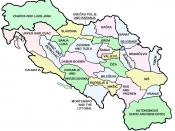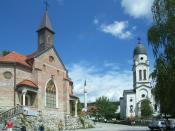Relations between the many ethnic groups in the Balkan region of Europe have been unstable for nearly one thousand years. In 1054 A.D. when the Christian Church split in the Great Schism it was divided into two halves: the western Roman Catholic Church, with its capital city of Rome, and the Eastern Orthodox Church, with its headquarters in Constantinople. This eastern half of Christianity, known as the Byzantine Empire, became a melting pot of jealous, warring, and nationalistic ethnicities. Over the course of the eleventh up to the twentieth century, the Balkan region has been a part of more conquering empires than perhaps anywhere else on earth - from the Roman Empire to the Byzantine Empire, the Ottoman Empire and the Nazi Third Reich. Among these empires a number of ethnicities began to consolidate and recognize their desire for their own individual independent states, but after nearly one thousand years of living under an empire close together with little or no recognition of autonomy these peoples' claims to territory and sacred land became confused and overlapped.
As well as the conflicts over which ethnicities should rightfully possess which land, the separated churches continued to feud as well. Each considers themselves to be the one true Christian Church and their land to be sacred, while the other is destined to fall due to its anathematic views. The differing religious views have escalated in the twentieth century and become a greater problem in the Balkans, and are bound into the foundation of national identity and nationalism.
The Roman Catholic Church became engrained with Croatian nationalism beginning under the rule of the Ottomans. While the Serbs accepted their subordination under the Turks, the Croats came under the rule of the Hungarians and Austrians, a part of the Roman Catholic Church...


